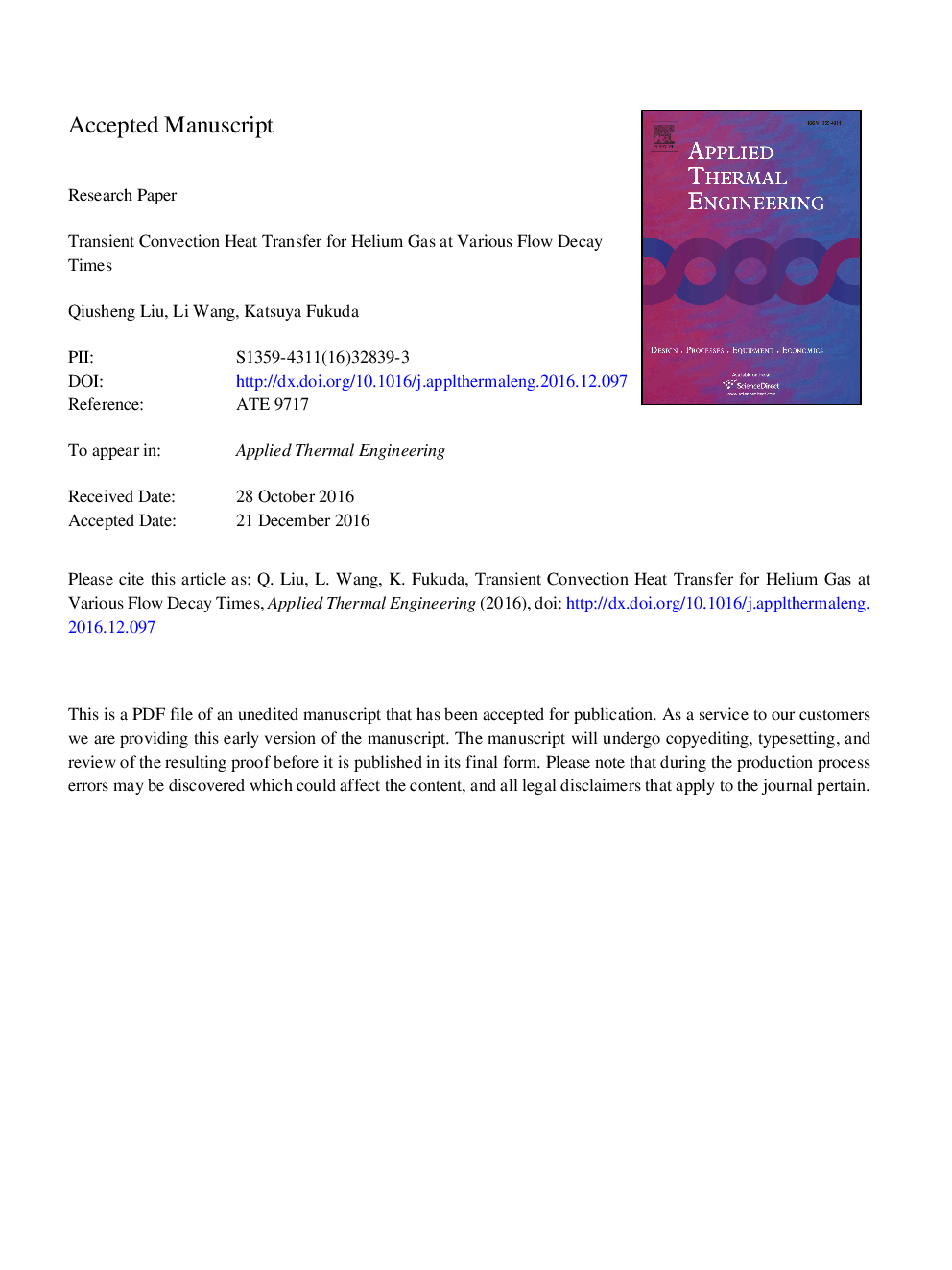| کد مقاله | کد نشریه | سال انتشار | مقاله انگلیسی | نسخه تمام متن |
|---|---|---|---|---|
| 4991446 | 1457113 | 2017 | 15 صفحه PDF | دانلود رایگان |
عنوان انگلیسی مقاله ISI
Transient convection heat transfer for helium gas at various flow decay times
ترجمه فارسی عنوان
انتقال حرارت گرمای گذرا برای گاز هلیوم در زمان های مختلف پوسیدگی جریان
دانلود مقاله + سفارش ترجمه
دانلود مقاله ISI انگلیسی
رایگان برای ایرانیان
کلمات کلیدی
ترجمه چکیده
برای انتقال یک سیلندر افقی در گاز هلیوم تحت شرایط پوسیدگی جریان، آزمایشی انتقال حرارتی گذرا به صورت آزمایشی مورد بررسی قرار گرفت. آزمایش با استفاده از گاز هلیوم به عنوان خنک کننده و یک سیلندر پلاتین به عنوان بخاری آزمایش انجام شد. نرخ تولید نسبی حرارت به سیلندر اعمال شد. دمای سیلندر در یک مقدار طراحی شده تحت یک جریان اولیه اولیه و میزان تولید گرما نگهداری می شود. سپس سرعت جریان گاز گاز هلیم با توجه به توابع خطی طراحی شده با زمان های مختلف تخریب جریان کاهش می یابد. دمای سطح سیلندر و شار گرما در طی فرایند گذار فسیلی جریان برای زمان های مختلف تخریب جریان، سرعت جریان اولیه و نرخ تولید گرما اندازه گیری شد. مشخص شد که دمای سیلندر به سرعت افزایش می یابد برای زمان کوتاه تر شدن فاز جریان در طی فرآیند فرسایش جریان. افزایش نرخ تغییرات سطح برای یک نرخ تولید بالاتر گرما بیشتر بود. ضریب انتقال حرارت نیز در جریان فرآیند انبساط جریان حاصل شد. مشخص شد که ضریب انتقال حرارت به مقدار ثابت برای هر زمان پوسیدگی جریان برای یک نرخ تولید قطعی قطعی و یک سرعت جریان اولیه قطعی کاهش می یابد و نرخ کاهش برای زمان کوتاهتر شدن زمان انبساط بیشتر است.
موضوعات مرتبط
مهندسی و علوم پایه
مهندسی شیمی
جریان سیال و فرایندهای انتقال
چکیده انگلیسی
Transient convection heat transfer was experimentally studied for a horizontal cylinder in helium gas under flow decay conditions. The experiment was conducted by using helium gas as the coolant, and a platinum cylinder as the test heater. A uniform heat generation rate was applied to the cylinder. The cylinder temperature was maintained at a design value under a specific initial flow rate and heat generation rate. Then, the flow rate of the helium gas started to decrease according to the designed linear functions, with different flow decay times. The surface temperature of the cylinder and the heat flux were measured during the flow decay transient process for various flow decay times, initial flow velocities, and heat generation rates. It was found that the temperature of the cylinder increased rapidly for a shorter flow decay time during the flow decay process. The increment of the surface temperature difference was higher for a higher heat generation rate. The transient heat transfer coefficient was also obtained during the flow decay process. It was clarified that the heat transfer coefficient decreased to a constant value for each flow decay time for a definite heat generation rate and a definite initial flow velocity, and the decrease rate was higher for a shorter flow decay time.
ناشر
Database: Elsevier - ScienceDirect (ساینس دایرکت)
Journal: Applied Thermal Engineering - Volume 116, April 2017, Pages 355-363
Journal: Applied Thermal Engineering - Volume 116, April 2017, Pages 355-363
نویسندگان
Qiusheng Liu, Li Wang, Katsuya Fukuda,
